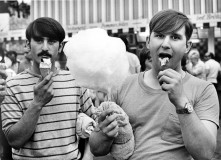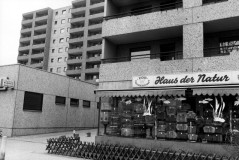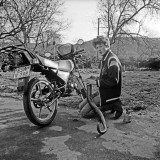- Gabriele und Helmut Nothhelfer,
Amerikanische Soldaten auf dem Deutsch-Amerikanischen Volksfest, Berlin 1974
© Gabriele und Helmut Nothhelfer
- Uwe J. Haack, Haus der Natur, Berlin 1987
aus der Serie Unser schöner Neuer Wedding
© Uwe J. Haack
- Roland Kopp, Rambach - Nordhessen, November 1982, der Serie Jugend eines nordhessischen Dorfes
© Roland Kopp
Ausstellungsort: Torhäuser
Eröffnung: 24.04.2014, 18 Uhr
(English version down below)
Eine Ausstellung anlässlich des 30. Geburtstages des Museums für Photographie Braunschweig e.V.
Mit Arbeiten von Aginmar, Wilfried Bauer, André Gelpke, Joachim Giesel, Uwe J. Haack, Roland Kopp, Hans-Martin Küsters, Angela Neuke, Gabriele und Helmut Nothhelfer und Michael Schmidt
“The Steinert school is dead!” Lange lebe die Steinert Schule! So müsste man aus dem heutigen Blickwinkel André Gelpkes vehemente Kritik von 1980 an einer am Kommerziellen ausgerichteten Ausbildung an der Folkwangschule für Gestaltung, der ehemaligen Wirkstätte Steinerts wohl folgerichtig ergänzen.
Das Jahr 1979 markiert ein Schlüsseljahr der westdeutschen Fotoszene und Fotogeschichte der Bundesrepublik Deutschland. Mit Klaus Honnefs Schlagwort der „Autorenfotografie“ verdichtete sich in den späten 1970er und frühen 1980er Jahren eine theoretische Matrix (Christoph Schaden 2013), welche die bisherigen Erörterungen und Ausführungen zum fotografischen Medium in Bewegung versetzte. Eindringlich belegt durch Honnefs Ausstellung „In Deutschland“ präsentierte die Schau zahlreiche der wichtigen jungen Fotografen und aufstrebenden Talente der Epoche. Diese Ausstellung, aber ebenso die vielen anderen zur Kontroverse anregenden fotografischen Ausstellungsprojekte der Zeit, behaupteten die Fotografie nachdrücklich als künstlerisches Ausdrucksmittel im Nachklang der so genannten Mediendocumenta 6. Sie bewiesen gleichzeitig, dass die Steinert Schule alles andere als tot war. Im Gegenteil, die von der wohl charismatischsten Person der bundesdeutschen Nachkriegsgeschichte ausgebildeten jungen Fotografen – wie auch die Absolventen anderer akademischer Fotozentren, die sich gerade etablierten – entwickelten mit der so genannten Autorenfotografie eine neue Stilrichtung und traten nunmehr selbstbewusst als künstlerische Fotografen auf. Mit einer neuen Herangehensweise, die das subjektive Moment der Fotografie als Selektion und Konstruktion von Wirklichkeit mit einer prägnanten Inhaltlichkeit verband, die Fotografie als Analyse der gesellschaftlichen Wirklichkeiten verstand, prägten die beteiligten Fotografen ein neues Verständnis von Fotografie. So ist es verständlich, dass die Faszination, die von den Steinert Schülern ausging, in der gesamten Bundesrepublik Deutschland überaus groß war.
Die sich ausbildende Vielzahl miteinander korrespondierender Fotografen, akademischer Ausbildungszentren und Fotogalerien stehen aber noch für ein weiteres Kapitel bundesdeutscher Fotogeschichte: Das spannungsgeladene Diskursfeld Fotografie inspirierte im Vorfeld und Nachklang der documenta auch die zahlreichen Gründungen fotografischer Sammlungen und Fotogalerien der Epoche. Erst in der zweiten Hälfte der 1970er Jahre konnte die Fotografie in Westdeutschland als autonomes, gleichberechtigtes künstlerisches Medium etabliert und in den Museen institutionalisiert werden.
Die Ausstellung „Schöne Neue BRD? Autorenfotografie der 1980er Jahre“ bietet einen Einblick in das Werk von zehn wichtigen Positionen aus dem Umfeld der „Autorenfotografen“ und ihr fotografisches Werk der 1970er und 1980er Jahre. Die Ereignisse der Zeit werden in Bezug gesetzt zur Gründung des Hauses als gemeinnütziger Verein im Jahr 1984, die sich somit als eine der vielen maßgeblichen Initiativen der Etablierung und Institutionalisierung der Fotografie verstehen lässt.
Zur Ausstellung erscheint ein begleitender Katalog.
Symposium zur Ausstellung
Dienstag, 29.04.2014,14-19 Uhr
Tagungsort: Roter Saal, Schlossplatz 1, 38100 Braunschweig
Es sprechen: Karen Seggelke (Gründungsmitglied Museum für Photographie), Dr. Ulrich Pohlmann (Sammlungsleiter Fotomuseum München), Prof. Dr. Christoph Schaden (Technische Hochschule Nürnberg), Prof. Manfred Schmalriede (Neue Schule für Fotografie Berlin) und Prof. Thomas Weski (Hochschule für Grafik und Buchkunst Leipzig). Weitere Infos hier.
Gefördert durch
+ + +
An exihibition on occation of the 30th birthday of the Museum für Photographie Braunschweig e.V.
With works by Aginmar, Wilfried Bauer, André Gelpke, Joachim Giesel, Uwe J. Haack, Roland Kopp, Hans-Martin Küsters, Angela Neuke, Gabriele and Helmut Nothhelfer and Michael Schmidt
„The Steinert school is dead!“ Long live the Steinert school! That’s how André Gelpkes vehement critique on a commercially-oriented form of education of the Folkwangschule für Gestaltung, the former workplace of Steinert, could possibly be amended.
The Year 1979 marks a crucial moment in West-german photography and the photographic history of the Federal Republic of Germany. During the late 1970s and early 1980s a theoretical matrix condensed under the term of “Autorenfotografie”, established by Klaus Honnef, initiating the reassessment of previous discussions and explanations concerning the photographic medium. Furthermore, the term was impressively demonstrated by Honnefs exhibition “In Deutschland”, which showed numerous of important young photographers and up-coming talents from that era. This exhibition, as well as the many other controvercially discussed exhibition-projects at that time, asserted photography as an artistic means of expression in the reverberation of the so-called Mediendocumenta 6. They simultaneously proved, that the Steinert school was far from being dead. Quite the contrary. With the “Autorenfotografie” those graduates, thaught by one of the most charismatic persons of the post-war era photo scene – as well as graduates from other academic photocenters – developed a new style, which simultaneously asserted their new self conscience as artistic photographers. By utilizing a new approach, in which the subjective moment of photography as a selection and design of reality was combined with a concise content,and a tought of photography as an analysis of social reality, those photographers involved coined a new understanding of photography’s documentary function. Thus – by transforming old conventions – it is understandable that a strong faszination emitted by the pupils of Steinert throughout the whole Federal Republic of Germany.
Besides this new style, an accumulating numbers of photographers, educational centers and photo galleries arise during the era and thereby marked another significant chapter in German photohistory: a tensed discourse of photography inspired numerous foundations of galleries and collections before and after the documenta. In Western germany it wasn’t before the second half of the 1970s that photography was established as an autonomic an emancipated artistical medium and institutionalized by museums.
The exhibition “Schöne Neue BRD? Autorenfotografie der 1980er Jahre” offers an insight into the oeuvres of ten important positions form the circle of the „Autorenfotografen“ and shows artworks from the 1970s and 1980s. The events from that time are linked to the foundation of the Museum für Photographie as a non-profit organization in the year 1984, which can therefore be perceived as one of those (many) initiatives to establish and institutionalize photography.
Accompanying to the exhibition a catalogue will be published.



